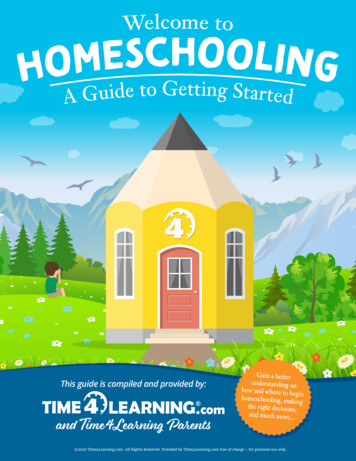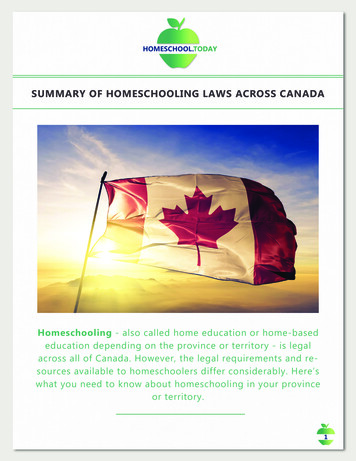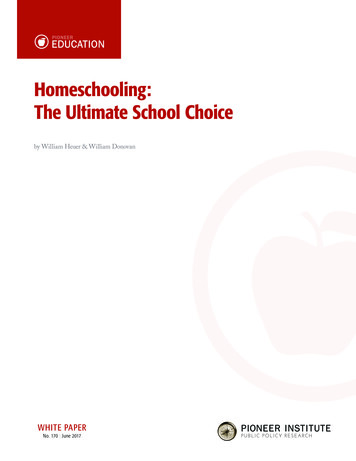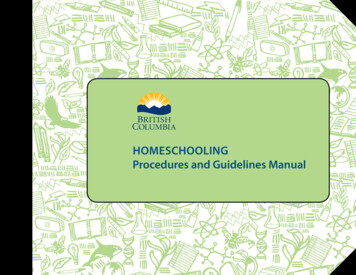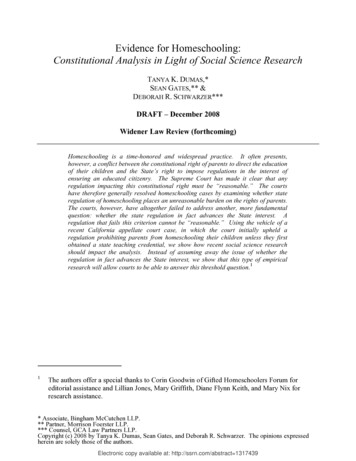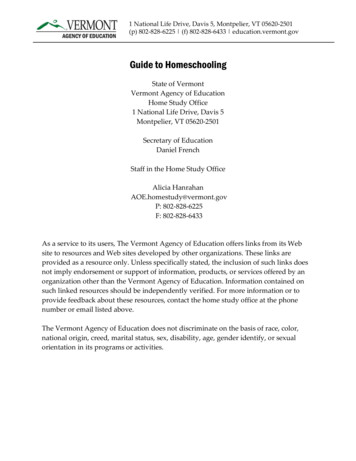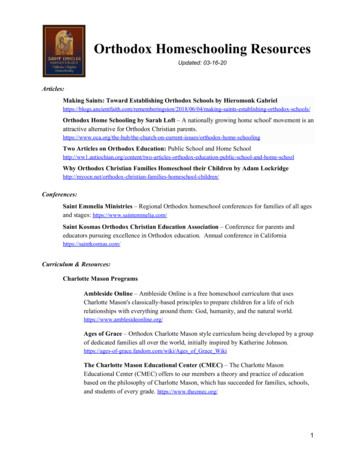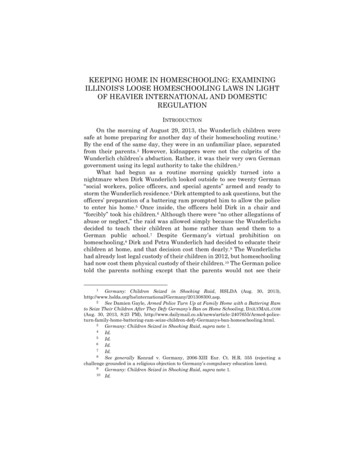
Transcription
KEEPING HOME IN HOMESCHOOLING: EXAMININGILLINOIS’S LOOSE HOMESCHOOLING LAWS IN LIGHTOF HEAVIER INTERNATIONAL AND DOMESTICREGULATIONINTRODUCTIONOn the morning of August 29, 2013, the Wunderlich children weresafe at home preparing for another day of their homeschooling routine. 1By the end of the same day, they were in an unfamiliar place, separatedfrom their parents.2 However, kidnappers were not the culprits of theWunderlich children’s abduction. Rather, it was their very own Germangovernment using its legal authority to take the children.3What had begun as a routine morning quickly turned into anightmare when Dirk Wunderlich looked outside to see twenty German“social workers, police officers, and special agents” armed and ready tostorm the Wunderlich residence.4 Dirk attempted to ask questions, but theofficers’ preparation of a battering ram prompted him to allow the policeto enter his home.5 Once inside, the officers held Dirk in a chair and“forcibly” took his children.6 Although there were “no other allegations ofabuse or neglect,” the raid was allowed simply because the Wunderlichsdecided to teach their children at home rather than send them to aGerman public school.7 Despite Germany’s virtual prohibition onhomeschooling,8 Dirk and Petra Wunderlich had decided to educate theirchildren at home, and that decision cost them dearly. 9 The Wunderlichshad already lost legal custody of their children in 2012, but homeschoolinghad now cost them physical custody of their children.10 The German policetold the parents nothing except that the parents would not see their1Germany: Children Seized in Shocking Raid, HSLDA (Aug. 30, y/201308300.asp.2See Damien Gayle, Armed Police Turn Up at Family Home with a Battering Ramto Seize Their Children After They Defy Germany’s Ban on Home Schooling, DAILYMAIL.COM(Aug. 30, 2013, 8:23 PM), y: Children Seized in Shocking Raid, supra note 1.4Id.5Id.6Id.7Id.8See generally Konrad v. Germany, 2006-XIII Eur. Ct. H.R. 355 (rejecting achallenge grounded in a religious objection to Germany’s compulsory education laws).9Germany: Children Seized in Shocking Raid, supra note 1.10 Id.
410REGENT UNIVERSITY LAW REVIEW[Vol. 27:409children “ ‘anytime soon.’ ”11 Three long weeks passed before theWunderlich family was reunited, but this reunification also brought therequirement that the children attend state school.12The Wunderlich family’s situation presents an extreme case ofgovernment regulation of home education. However, Germany is not theonly country that prohibits or severely restricts homeschooling. 13Currently, at least twenty-eight countries prohibit homeschooling, andthirty others allow it with heavy restrictions. 14 Despite internationalhostility, home education is allowed in all fifty states in the UnitedStates.15 Several of those states, such as Illinois, impose little regulationon home education.16 Despite this minimal regulation in the UnitedStates, some are calling for greater restrictions. 17 This Note examineswhether states like Illinois should change their home educationrequirements when parents have a right to choose their children’seducation, other states more strictly regulate homeschooling, and manycountries impose severe restrictions and prohibitions on homeschooling.Part I discusses the history and background of homeschooling as well asits current status in the United States. Part II examines domesticregulation of homeschooling by focusing on the loose regulation of Illinoisas well as the stricter regulation of other states. Part III focuses oninternational regulation and prohibition of homeschooling, and Part IVexplains why states like Illinois should not increase their regulation ofhome education.I. BACKGROUNDHomeschooling may appear to be a recent phenomenon, but it has along history. In fact, some of history’s most influential men, such asGeorge Washington and Thomas Edison, received a home education.1811Id.Press Release, Home Sch. Legal Def. Assoc., Wunderlich Children Returned onCondition of School Attendance (Sept. 19, 2013), 13 See infra Part III.14 Alicia Bayer, Which Countries Have Banned Homeschooling?, EXAMINER.COM (May26, 2013, 2:34 PM) ve-bannedhomeschooling.15 JudithG. McMullen, Behind Closed Doors: Should States RegulateHomeschooling?, 54 S.C. L. REV. 75, 87 (2002); State Laws, HSLDA, https://www.hslda.org/laws/ (last visited Apr. 13, 2015).16 See infra Part II.A.17 NAT’L EDUC. ASS’N, 2014-2015 NEA RESOLUTIONS Res. B-83 (2014–2015),available at 4-15.pdf.18 See RONALD W. CLARK, EDISON: THE MAN WHO MADE THE FUTURE 9 (1977);THOMAS S. LANGSTON & MICHAEL G. SHERMAN, GEORGE WASHINGTON 16 (2003).12
2015]KEEPING HOME IN HOMESCHOOLING411Homeschooling is an American tradition, 19 and a brief examination of itshistory and the legal rights affecting it provides a helpful starting point. 20A. The History of Homeschooling in the United StatesHomeschooling was a part of American history even before the UnitedStates gained its independence.21 “From colonial times until well into thenineteenth century,” children often had some sort of home educationwithin their lifetime.22 Compulsory attendance laws did not exist in theUnited States until Massachusetts passed the first one in 1852. 23However, that law allowed children to attend other schools chosen by theparents—and, one might argue, allowed for home education. 24 Thecompulsory attendance laws eventually clashed with the right of parentsto choose whether their children would be taught at home. This basic ideaof parental choice was eventually established for the entire nation inMeyer v. Nebraska.25 In that case, the United States Supreme Court foundthat parents had the right to direct the upbringing of their child.26 Thisruling was later reaffirmed in Pierce v. Society of Sisters.27In Pierce, the Supreme Court held that an Oregon compulsoryattendance law “unreasonably interfere[d] with the liberty of parents andguardians to direct the upbringing and education of children under theircontrol.”28 Thus, based on Pierce, parents may direct the education of their19See McMullen, supra note 15, at 76.A detailed history of homeschooling and the legal rights affecting it are beyond thescope of this Note.21 McMullen, supra note 15, at 76.22 Id.23 ELLWOOD P. CUBBERLEY, PUBLIC EDUCATION IN THE UNITED STATES 563 (1947);see 1852 Mass. Acts 170–71 (“SECT. 1. Every person who shall have any child under hiscontrol, between the ages of eight and fourteen years, shall send such child to some publicschool within the town or city in which he resides, during at least twelve weeks, if the publicschools within such town or city shall be so long kept, in each and every year during whichsuch child shall be under his control, six weeks of which shall be consecutive.”).24 See 1852 Mass. Acts 171 (“SECT. 4. If, upon inquiry by the school committee, itshall appear, or if upon the trial of any complaint or indictment under this act it shall appear,that such child has attended some school, not in the town or city in which he resides, for thetime required by this act, or has been otherwise furnished with the means of education for alike period of time, or has already acquired those branches of learning which are taught incommon schools, or if it shall appear that his bodily or mental condition has been such as toprevent his attendance at school, or his acquisition of learning for such a period of time, orthat the person having the control of such child, is not able, by reason of poverty, to sendsuch child to school, or to furnish him with the means of education, then such person shallbe held not to have violated the provisions of this act.” (emphasis added)).25 262 U.S. 390 (1923).26 See id. at 400–01.27 268 U.S. 510, 534–35 (1925).28 Id. (emphases added).20
412REGENT UNIVERSITY LAW REVIEW[Vol. 27:409children.29 Additionally, the Court states, “[t]he child is not the merecreature of the State; those who nurture him and direct his destiny havethe right, coupled with the high duty, to recognize and prepare him foradditional obligations.”30 Although this case does not directly deal withhomeschooling,31 the right the Court so strongly emphasizes is afoundational element of the parental right to educate children at home. 32However, Pierce does not limit the government’s ability to regulateschools, teachers, or child attendance.33 Despite this fact, Pierce and Meyerestablish a foundation for parental rights that supports parents’ ability toeducate their children at home.34 The right of parents to direct theupbringing of their children has often been the basis for argumentsagainst restrictive state homeschooling laws. 35 As a result, “the battle hasintensified around the fundamental issue of whether the parental right orthe state’s duty should prevail in the education of children.” 36Some people, such as Judith G. McMullen, express doubt as to therelevance of Meyer and Pierce to the homeschooling debate. McMullen, alaw professor at Marquette University Law School, points out thatalthough Meyer is used as a foundational case for parental rights in thehomeschooling debate, “the opinion itself does not seem to contemplate ahomeschooling situation.”37 While McMullen correctly points out thatMeyer is not a homeschooling case, the opinion supports parents’ right todetermine the upbringing of their children, and this parental rightextends to homeschooling.38 The only reason Meyer did not considerhomeschooling was because homeschooling was not the situation athand.39 Despite these concessions, the Meyer Court stated that the“education of the young is only possible in schools conducted by especially29CHRISTOPHER J. KLICKA, THE RIGHT TO HOME SCHOOL 35 (2d ed. 1998).Pierce, 268 U.S. at 535 (emphasis added).31 Pierce deals with the Oregon Compulsory Education Act, which required parentsand guardians to send children between the ages of eight and sixteen in their care to thepublic school in the district where they resided. Id. at 530. Society of Sisters, an operator ofprivate schools, sued and received an injunction against the law’s implementation. Id. at529–30, 536.32 See KLICKA, supra note 29.33 Pierce, 268 U.S. at 534.34 KLICKA, supra note 29, at 33.35 See McMullen, supra note 15, at 91, 93.36 Aaron T. Martin, Note, Homeschooling in Germany and the United States, 27 ARIZ.J. INT’L & COMP. L. 225, 254 (2010).37 McMullen, supra note 15, at 75, 91.38 See KLICKA, supra note 29, at 34.39 The appellee in Meyer challenged his conviction under a Nebraska state law thatforbade any person from teaching students below ninth grade any subject in a language otherthan English. Meyer v. Nebraska, 262 U.S. 390, 396–97 (1923).30
2015]KEEPING HOME IN HOMESCHOOLING413qualified persons who devote themselves thereto.” 40 This statement mayinclude homeschooling for several reasons. First, “especially qualifiedpersons” is a broad, vague term that could include parents. 41 Second,homeschooling parents often “devote themselves” to educating theirchildren.42 While it may be true that some homeschooling parents do notfully devote themselves to educating their children, it is also true thatsome public or private school teachers fail in the same area. 43 Thus, Meyerapplies to homeschooling, but the strongest application is based on theparents’ right to direct their children’s upbringing.McMullen also questions whether Pierce is applicable to thehomeschooling situation. She claims that “one cannot reasonably readPierce’s defense of parental prerogatives in a child’s education to discreditcompulsory education laws, nor did later Supreme Court cases treat itthat way.”44 However, McMullen’s argument is problematic becausechallenging compulsory education laws and supporting homeschooling aretwo different topics.45 Pierce simply establishes parental rights ineducation, and those rights support homeschooling.46 Even if McMullenwere correct about Meyer and Pierce supporting the state’s ability toregulate the education of children,47 these two cases do not prohibithomeschooling. Rather, Meyer and Pierce establish parental rights thatsupport home education.48Another case that aided the establishment of parental rights wasPrince v. Massachusetts.49 In this case, the Supreme Court determinedthat “the custody, care and nurture of the child reside first in the parents,whose primary function and freedom include preparation for obligationsthe state can neither supply nor hinder.”50 Like Meyer and Pierce, this casestrengthens parental rights.51 However, some suggest that Prince “can beread both to support unrestricted homeschooling and homeschooling40Id. at 400.See id. The Court does not provide any guidance as to what sort of qualificationsallow a person to effectively educate the young.42 See id. This statement begs the question: Who is more devoted to seeing a childsucceed than the child’s parents?43 See Martin, supra note 36, at 255.44 McMullen, supra note 15, at 93.45 Rather than focusing on the value of compulsory education laws, this Note focuseson a suggested response to homeschooling regulations.46 See Louis A. Greenfield, Note, Religious Home-Schools: That’s Not a Monkey onYour Back, It’s a Compelling State Interest, 9 RUTGERS J.L. & RELIGION 1, 4 (2007).47 See McMullen, supra note 15, at 91–93.48 See KLICKA, supra note 29, at 33.49 321 U.S. 158 (1944).50 Id. at 166.51 KLICKA, supra note 29, at 36.41
414REGENT UNIVERSITY LAW REVIEW[Vol. 27:409regulation.”52 Although the case discusses the “obligation to care for thechild and to prepare him for life in society,” it also appears to supportregulation of homeschooling by seemingly recognizing “that the state hasa legitimate interest in protecting children from dangers that theirparents have not adequately protected against.” 53 Thus, Prince highlightsthe tension between parents’ right to direct their children’s upbringingand the state’s interest in protecting the best interests of every child.The Supreme Court did not consider a homeschooling situation untilit examined Wisconsin v. Yoder.54 In this case, Amish parents desired tokeep their children from attending school after eighth grade.55 Further,they wished to educate their children within the Amish community ratherthan allow them to enter the public school system. 56 The parents thereforechallenged Wisconsin’s compulsory attendance law.57 This challengeeventually came before the Supreme Court, and the Court ruled in favorof the Amish family by refusing to force the children into public school. 58However, McMullen contends that Yoder “would easily support regulationof homeschoolers who were not motivated primarily by religious belief butwould impose a much higher burden on the state in justifying regulationof homeschooling undertaken for religious purposes.” 59 Due to this belief,McMullen concludes that loose regulation of homeschooling is madepossible by the “burden of separating religious motivations fromnon-religious motivations” in addition to the difficulty of determining aperson’s religious sincerity.60 Yoder does not clarify everything about thehomeschooling debate, but it provides additional support for the parentalright to choose home education for children. 61 Although the religiousmotivation of some parents who teach their children at home plays a rolein the regulation of home education, the basic right of parents to directtheir children’s upbringing allows them to educate their children at home.Despite McMullen’s arguments, Meyer, Pierce, Prince, and Yoderform the bedrock for parents’ right to choose homeschooling for theirchildren.62 Because parents have the right to direct the upbringing of theirchildren, they may choose to educate those children through5253545556575859606162McMullen, supra note 15, at 94.Id.406 U.S. 205 (1972).Id. at 207.Id. at 209.Id. at 208–09.Id. at 234.McMullen, supra note 15, at 97.Id.See Yoder, 406 U.S. at 233–34; Greenfield, supra note 46, at 5.See KLICKA, supra note 29, at 33–37.
2015]KEEPING HOME IN HOMESCHOOLING415homeschooling. Some may interpret these foundational cases differently,but it is difficult, if not impossible, to deny the parental rights that havebeen established. America has a rich history of home education, 63 andhome education continues despite various attacks.64 However, there arechallenges on the horizon as homeschooling is assailed both domesticallyand internationally.B. The Current Status of Homeschooling in the United StatesThe current legal status of homeschooling is fluid. While all fiftystates currently allow some form of home education,65 the fact that “theUnited States has a far more developed body of law on the subject”compared to other nations does nothing to ensure a bright future forAmerican homeschooling.66 Despite abundant tension betweenhomeschoolers and state officials within the United States,“homeschooling has moved from being a fringe movement to a thrivingmainstream practice.”67 However, other cases have raised questions inspite of this wider general acceptance of homeschooling. In Runyon v.McCrary,68 the Supreme Court examined a private education case 69 thatcould be applicable to homeschooling. The Court stated that “whileparents have a constitutional right to send their children to privateschools and a constitutional right to select private schools that offerspecialized instruction, they have no constitutional right to provide theirchildren with private school education unfettered by reasonablegovernment regulation.”70 The Third Circuit used similarly vagueterminology in Combs v. Homer-Center School District.71 In that case, theThird Circuit determined that there was no constitutional right forparents “to avoid reasonable state regulation of their children’seducation.”72 Based on the two cases above, the natural question is: Whatis reasonable? Summarizing the scholarship on the subject, one writersuggests that reasonable regulation “should withstand challenges from63McMullen, supra note 15, at 76–77.See Kevin D. Williamson, They Are Coming for Your Children, NAT’L REV. ONLINE(Oct. 7, 2014, 4:00 AM), are-comingyour-children-kevin-d-williamson (noting opposition to homeschooling and governmentefforts to restrict homeschooling access).65 McMullen, supra note 15; State Laws, supra note 15.66 Martin, supra note 36, at 272.67 Id. at 254.68 427 U.S. 160 (1976).69 Id. at 163–67.70 Id. at 178 (emphasis added).71 540 F.3d 231 (3d Cir. 2008).72 Id. at 249 (emphasis added).64
416REGENT UNIVERSITY LAW REVIEW[Vol. 27:409parents seeking to circumvent those regulations.” 73 Despite the differentcourts’ use of vague terminology, homeschooling is still legal–and growing.Outside of the legal realm, the current status of homeschoolingappears to be positive. Traditionally, religion has been the primary reasonfor homeschooling, and it is still an important factor in the decision toeducate children at home.74 About eighty-three percent of those whoeducate their children at home claim religion as one of their reasons forhomeschooling, and the majority of these are conservative Christians.75These parents choose homeschooling to ensure that their children receive“a religious education that inculcates values and beliefs not taught inpublic schools.”76 However, religion is not the only reason forhomeschooling.77 Many parents have found a variety of other reasons toteach their children at home, such as “dissatisfaction with the local schoolsystem, caring for special-needs kids, safety concerns, flexibility to traveland the chance to spend more time with their children.” 78 Based on thesereasons, the number of families choosing home education has beensteadily increasing.79 According to the National Home Education ResearchInstitute (NHERI), homeschooling has been increasing an estimated twoto eight percent per year over the last few years.80 In the spring of 2010,there were “an estimated 2.04 million home-educated students . . . in theUnited States.”81 As for academic performance, home-educated studentsoften perform better academically than their public school counterparts. 82In fact, children who are educated at home usually score fifteen to thirtypercentile points higher than public school students do on standardizedacademic achievement tests.83 This positive status of home education inthe United States provides a helpful backdrop for examining the types oflaws and regulations that several states have put in place.73Martin, supra note 36, at 272.Vidya Rao, As Home-Schooling Moves to Mainstream, Stigma Fades, TODAY(Sept. 27, 2010, 9:12 AM), g -fades/#.UkWbURafY20.75 Id.76 McMullen, supra note 15, at 78.77 Brian D. Ray, Research Facts on Homeschooling, NHERI (Jan. 6, 2015),http://www.nheri.org/ResearchFacts.pdf.78 Rao, supra note 74.79 See Ray, supra note 77.80 Id.81 Id.82 Id.83 Id.74
2015]KEEPING HOME IN HOMESCHOOLING417II. DOMESTIC REGULATION OF HOMESCHOOLINGEach state takes a different approach to regulating home education.For example, some states treat home schools as private schools, whileother states have stricter laws directly aimed at homeschooling.84 Otherstates allow children to avoid the requirements of a compulsory educationlaw if the parents prove they are providing an education equivalent towhat the state requires under the compulsory education laws. 85 Theseregulations “vary greatly from state to state and may includerequirements for home teacher certification, curriculum, and otherrestrictions.”86 To simplify the many different approaches, it is helpful toexamine the states based on whether they impose loose, moderate, orheavy regulations on home education. The following section examinesspecific states as examples of these differing levels of regulation onhomeschooling.A. States with Loose Requirements on HomeschoolingIllinois is one of several states that do not require parents to initiatecontact with the state before beginning home education.87 Illinois providesa good example of a state with loose regulation on home education. Forinstance, home-educated students in Illinois are not required to takestandardized tests, and parents teaching their children at home do notneed any specific teacher qualifications.88 A basic overview of Illinois lawreveals that Illinois does not have a statute specifically dealing withhomeschooling.89 As a result, it is necessary to examine other Illinoisstatutes that affect education. The Illinois School Code does not requirechildren to attend public schools as long as the children attend a schoolwhere they “are taught the branches of education . . . in the Englishlanguage.”90 In addition to the English requirement, the branches ofeducation must be the same as those taught to public school children who84McMullen, supra note 15, at 87, 89.Id. at 88–89.86 Id. at 89.87 State Laws, supra note 15 (listing Alaska, Connecticut, Guam, Idaho, Illinois,Indiana, Iowa, Michigan, Missouri, New Jersey, Oklahoma, Puerto Rico, and Texas asjurisdictions which do not require homeschooling parents to initiate contact with the state);see also 105 ILL. COMP. STAT. 5/2-3.25o(b), (e) (Westlaw through P.A. 98-1174, 2014 Reg.Sess.) (allowing “non-public” schools to voluntarily register with the state, but excluding any“home-based” school from the definition of “non-public school”).88 HOME SCH. LEGAL DEF. ASS’N, HOME SCHOOLING IN THE UNITED STATES: A LEGALANALYSIS—ILLINOIS IL-2 (2014-2015 ed.) [hereinafter A LEGAL ANALYSIS—ILLINOIS],available at http://www.hslda.org/laws/analysis/Illinois.pdf.89 Id. at IL-1.90 105 ILL. COMP. STAT. ANN. 5/26-1(1) (Westlaw through P.A. 98-1150, 2014 Reg.Sess.).85
418REGENT UNIVERSITY LAW REVIEW[Vol. 27:409are the same age and in the same grade.91 The “areas of education” inwhich a child must be taught “include the language arts, mathematics,the biological, physical and social sciences, the fine arts and physicaldevelopment and health.”92 Thus, parents who meet the statutoryrequirements are allowed to decide how, when, and what to teach theirchildren.93 In fact, Illinois considers homeschooling “a form of privateeducation” as long as home-educated students satisfy the requirements ofSection 26-1 of the Illinois School Code.94In addition to statutory law, some Illinois case law also affects thestate’s regulation of home education. In People v. Levisen,95 the IllinoisSupreme Court held that the compulsory education laws were “enacted toenforce the natural obligation of parents to provide an education for theiryoung, an obligation which corresponds to the parents’ right of controlover the child.”96 In addition to explaining the reason for enactment ofcompulsory education laws, the court determined that the goal of theselaws is simply the education of children rather than a requirement thatthey be “educated in any particular manner or place.”97 By notinterpreting compulsory education laws as limiting education to a specificprocedure or location, the court essentially allowed homeschooling. 98 Inaddition to its analysis of compulsory education laws, the court definedschool as “a place where instruction is imparted to the young” regardlessof the number of people being taught there. 99 This definition clearlyincludes home education, and the court clarified itself when it stated, “[w]edo not think that the number of persons, whether one or many, make aplace where instruction is imparted any less or more a school.” 100 Thus,the Levisen decision, which is still good law,101 includes homeschooling asan acceptable form of education in Illinois.In the event of a truancy action against homeschooling parents inIllinois, the parents must prove that they are acting in accordance with91Id.Id. § 27-1 (Westlaw).93 See Illinois Home Schooling, ILL. STATE BD. EDUC., http://www.isbe.state.il.us/homeschool/ (last visited Apr. 13, 2015).94 Id.; see § 26-1(1) (Westlaw).95 90 N.E.2d 213 (Ill. 1950).96 Id. at 215.97 Id.98 See id.99 Id.100 Id.101 See Gallarneau ex rel. Gallarneau v. Calvary Chapel of Lake Villa, Inc., 992 N.E.2d559, 562 (Ill. App. Ct. 2013) (citing the holding in Levisen to support the conclusion that thegeneric term “school” has several meanings).92
2015]KEEPING HOME IN HOMESCHOOLING419the law.102 Because parents are given so much freedom in choosing howtheir child will be educated, they are also given “near-totalresponsibility . . . for their student’s education while they are beinghome- schooled.”103 Thus, parents have the burden to prove their homeeducation program complies with the law. 104 If a parent cannot satisfy thisburden of proof, “the regional superintendent may request the regional orschool district truant officer to investigate to see that the child is incompliance with the compulsory attendance law.” 105 In the event that aparent’s home education program does not satisfy state requirements, theparent may be guilty of a Class C misdemeanor, while the child will beconsidered truant.106 Thus, Illinois imposes loose requirements on homeeducation, but it also has laws in place to penalize homeschooling parentswho do not properly educate their children.Compared to the rest of the United States, the homeschoolingrequirements in Illinois are quite loose. However, some states such asIndiana, Iowa, Michigan, Missouri, and Texas are like Illinois in that theydo not require parents to initiate contact with the state. 107 Other statesrequire parental notification, but do not have many other requirements. 108Among these states are Alabama, California, Kentucky, Mississippi, andWisconsin.109 Regardless of this distinction, all of these states are similarto Illinois. In fact, Indiana and Kentucky, two states that border Illinois,also do not have home school statutes. 110 Another similarity is that neitherIndiana nor Kentucky has teacher qualifications or standardized tests. 111These two states also primarily rely on case law and statutory law that isnot directed specifically toward homeschooling.112 Interestingly, Indiana102A LEGAL ANALYSIS—ILLINOIS, supra note 88.Illinois Home Schooling, supra note 93.104 Levisen, 90 N.E.2d at 215–16; see also Illinois Home Schooling, supra note 93.105 Illinois Home Schooling, supra note 93.106 See 105 ILL. COMP. STAT. 5/26-11 (Westlaw through P.A. 98-1174, 2014 Reg. Sess.);Illinois Home Schooling, supra note 93.107 See State Laws, supra note 15.108 See id.109 See id.110 HOME SCH. LEGAL DEF. ASS’N, HOME SCHOOLING IN THE UNITED STATES: A LEGALANALYSIS—INDIANA IN-1 (2013-2014 ed.) [hereinafter A LEGAL ANALYSIS—INDIANA],available at http://www.hslda.org/laws/analysis/Indiana.pdf; HOME SCH. LEGAL DEF. ASS’N,HOME SCHOOLING IN THE UNITED STATES: A LEGAL ANALYSIS—KENTUCKY KY-1 (2013-2014ed.) [hereinafter A LEGAL ANALYSIS—KENTUCKY], available at 1 A LEGAL ANALYSIS—INDIANA, supra note 110, at IN-1 to IN-2; A LEGAL ANALYSIS—KENTUCKY, supra note 110, at KY-2.112 See A LEGAL ANALYSIS—INDIANA, supra note 110, at IN-1 to IN-2; A LEGALANALYSIS—KENTUCKY, supra note 110, at KY-1 to KY-2.103
420REGENT UNIVERSITY LAW REVIEW[Vol. 27:409has case law that is nearly identical to the Levisen case in Illinois.113 InState v. Peterman, the Indiana Appellate Court held that a school “is aplace where instruction is imparted to the young.”114 That court alsostated, “[w]e do not think that the number of persons, whether one ormany, make a place where instruction is imparted any less or more aschool.”115 Thus, Illinois is not alone in its loose regulation of homeeducation.B. States with Moderate Requirements on HomeschoolingSeveral st
Homeschooling is an American tradition,19 and a brief examination of its history and the legal rights affecting it provides a helpful starting point.20 A. The History of Homeschooling in the United States Homeschooling was a part of American history even before the United States gained its independence.21 "From colonial times until well into the
